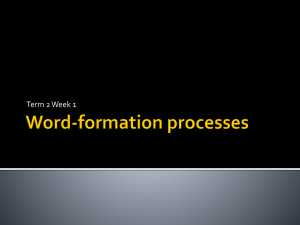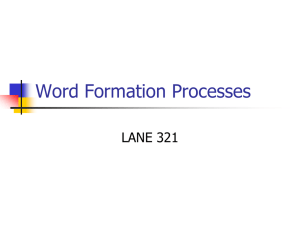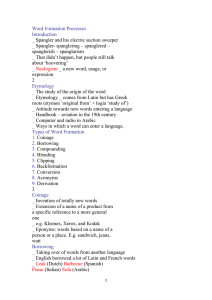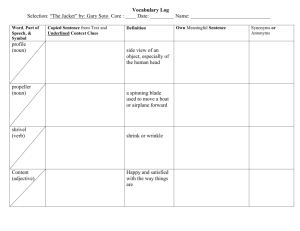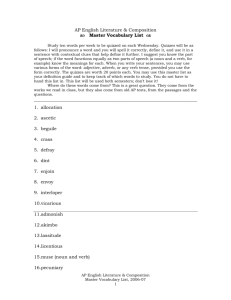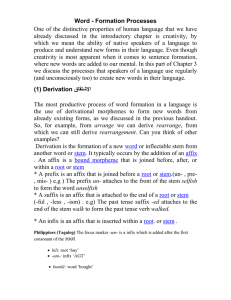Words and Word Formation Processes - Linguistics
advertisement
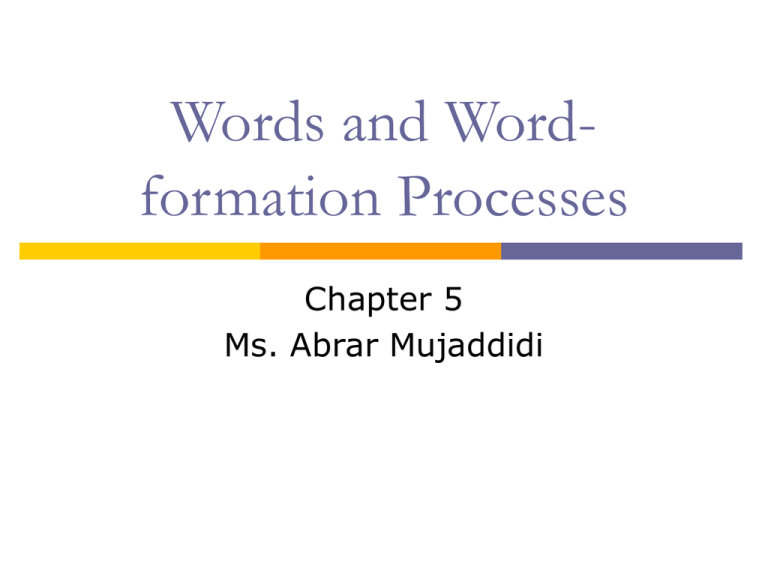
Words and Wordformation Processes Chapter 5 Ms. Abrar Mujaddidi Introduction We quickly understand new words in our language and accept the use of new forms of that new word. There is a lot of regularities in the wordformation processes in our language. In this chapter, we explore some of the processes of creating new words in a language. Etymology The study of the origin and history of a word is known as etymology. We should view the constant evolution of the words as a reassuring sign of vitality of the langusge. Coinage Coinage is the invention of totally new terms. Sources of coined words: 1. Trade names of commercial products that become general terms. e.g. aspirin, kleenex, teflon, xerox. 2. New words based on the name of a person or a place. e.g. hoover, jeans, sandwich. Borrowing Borrowing is taking over words from other languages. English borrows from other languages. e.g. sofa, lilac, croissant Many languages borrow from English e.g. Japanese. supaamaaketto cont., Loan translation: Direct translation of the elements of a word into the borrowing language. Many languages translated the term ‘skyscraper’ into its own vocabulary. Compare between borrowing and loantranslation? Compounding Compounding is the joining of two separate words to produce a single form. Compounding is very common in English and German. E.g. Compound nouns: Bookcase, doorknob, sunburn Compound adjectives: low-paid, good-looking Blending The combination of to separate forms to produce a single form is blending. BUT Blending is accomplished by taking the beginning of one word and joining it to the end of the other word. E.g. Smog (smoke + fog) brunch (breakfast + lunch) Spanglish (spanish + English) Clipping Clipping occurs when a word with more than one syllable is is reduced to a shorter form. E.g. gas (gasoline) fan (fanatic) ad ( advertisement) cont., A special type of reduction is hypocorisms: a longer word is reduced to a single syllable, then a –y or –ie E.g. movie (moving picture) hankie (handkerchief) Backformation In backformation, a word of one type (usually a noun) is reduced to form a word of another type (usually a verb). E.g. Televise donate babysit (television) (donation) (babysitter) Conversion Conversion is a change in the function of the word without any reduction. 1. Noun to a verb 2. verb to a noun 3. verb to adjective butter to spy to butter a spy see through a see-through material Acronyms Acronyms are new words formed from the initial letters of a set of other words. e.g. CD (compact disk) VCR (video cassette recorder) laser MADD ATM Derivation Derivation is accomplished by the use of affixes. Affixes prefixes added to the beginning of a word un- or dis- infixes not used in standard English suffixes added to the end of the word -ful or -less Multiple Processes It is possible to trace the operation of more than one process in the creation of a particular word. e.g. Deli snowball See you next class read chapter 7 please!!
